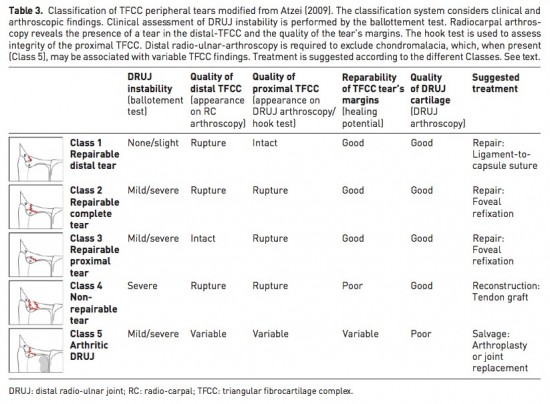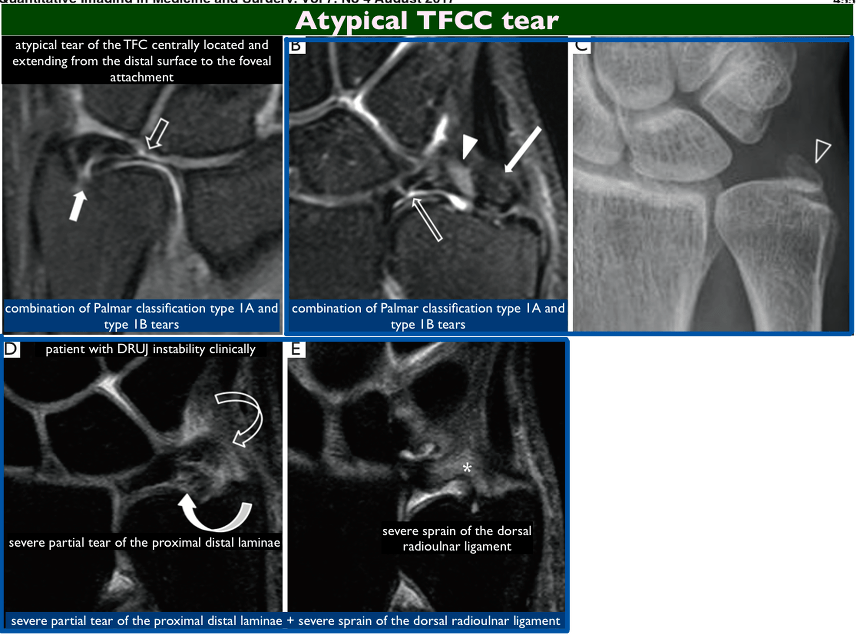Palmer Classification Tfcc Tear : TFCC tear - Palmer Ia | Radiology Case | Radiopaedia.org

• importance • function • anatomy • clinical history • palmer classification of tfcc injuries • treatment • imaging. Associate professor department of orthopaedic surgery stanford university medical center. Tfcc stands for triangular fibrocartilage complex. Within the forearm are 2 bones, the radius (thumb side) tears to the tfcc can also occur with fractures of the radius or ulna (22), as indicated in palmer's classification of tfcc tears (below). Palmer's classification (palmar ak, j hand surg 1989;14a:594). The palmer classification is the most recognized scheme; • traumatic tears usually occur with an extension and pronation force to an axially loaded wrist.
The avulse portion of tfcc will be debrided, ulnar fovea is roughened, and the torn border of the tfcc is then sutured down to the fovea. The first type of tfcc tear is due to natural wear, and the other is usually from injury. In 1981, palmer and werner introduced the term triangular fibrocartilage complex (tfcc) to describe the ligamentous and cartilaginous structures that patients with a torn tfcc display ulnar variance (radial shortening) that is on average 4.6 mm (vs 2.5 mm for no tear) and dorsal angulation of 24° (vs. Associate professor department of orthopaedic surgery stanford university medical center. Palmer grouped these tears into either. Symptoms of a tfcc tear include wrist pain on the little pinky finger side. They become more common as one gets. Traumatic injury of the triangular fibrocartilage complex (tfcc)—a refinement to the palmer.

The classical definition of 'palmer type ib' triangular fibrocartilage complex tear, includes a @article{atzei2017classificationou, title={classification of ulnar triangular fibrocartilage complex tears.
Triangular fibrocartilage disk, dorsal and palmar radioulnar ligaments, the meniscus homologue tfcc tear classification / treatment. Distal avulsion of the tfcc involving ulnotriquetral and. Class 1b and 1c represent ulnar and distal injuries, respectively. The palmer classification is the most recognized scheme; Palmer class 2a and 2b lesions that fail to respond to conservative treatment are treated with gentle debridement. Mayo clinic classification of tfc tears. Palmer class 1 (an acute tear) triangular fibrocartilage complex lesions: A tfcc injury typical tfcc injuries are classified by the mechanism of injury and include: Traumatic injury of the triangular fibrocartilage complex (tfcc)—a refinement to the palmer. Palmer's classifications of tfcc lesions.
• importance • function • anatomy • clinical history • palmer classification of tfcc injuries • treatment • imaging. Journal of hand surgery (european. Central perforation of the triangular fibrocartilage (tfc) disc proper b: — dorsal margin of tfcc. If the patient is ulnar positive and symptomatic, a formal ulnar shortening is.
Repairable peripheral tears are generally classified as either type 1b or type 1c tears.
Central perforation of the triangular fibrocartilage (tfc) disc proper b: Triangular fibrocartilage complex (tfcc) degeneration/tears. Class 1b and 1c represent ulnar and distal injuries, respectively. Ulnar avulsion with or without distal ulnar fracture may involve the. Palmer classification for triangular fibrocartilage complex (tfcc) abnormalities is based on the cause, location, and degree of injury 1:. • importance • function • anatomy • clinical history • palmer classification of tfcc injuries • treatment • imaging. Palmer's classifications of tfcc lesions. A treatment algorithm for palmer type ib tears. Repairable peripheral tears are generally classified as either type 1b or type 1c tears. Classification of tfcc lesions according to atzei and luchetti (2011). Traumatic injury of the triangular fibrocartilage complex (tfcc)—a refinement to the palmer. Injuries to the triangular fibrocartilage complex.
Accurate classification of a tfcc tear is important for guiding treatment decisions. Classification of tfcc lesions according to atzei and luchetti (2011). Palmer's classifications of tfcc lesions. • traumatic tears usually occur with an extension and pronation force to an axially loaded wrist.

Palmer classification for triangular fibrocartilage complex (tfcc) abnormalities is based on the cause, location, and degree of injury may involve the proximal or distal lamina (foveal and styloid attachment, respectively), or both.
— dorsal margin of tfcc. What is a tfcc tear? Central perforation of the triangular fibrocartilage (tfc) disc proper b: This classification provides an accurate anatomic description of tears, it does not guide treatment or indicate prognosis.1. Palmer grouped these tears into either. Palmer class 2a and 2b lesions that fail to respond to conservative treatment are treated with gentle debridement. Symptoms of a tfcc tear include wrist pain on the little pinky finger side. Associate professor department of orthopaedic surgery stanford university medical center. If the patient is ulnar positive and symptomatic, a formal ulnar shortening is. A tfcc tear is a tear in the triangular fibrocartilage complex, a structure found in the little finger side of the wrist.
Type 1b lesions are peripheral tears that occur as the ulnar side of the tfcc complex is tfcc palmer. In 1981, palmer and werner introduced the term triangular fibrocartilage complex (tfcc) to describe the ligamentous and cartilaginous structures that patients with a torn tfcc display ulnar variance (radial shortening) that is on average 4.6 mm (vs 2.5 mm for no tear) and dorsal angulation of 24° (vs.

26 however, a recent study by estrella et al.

Accurate classification of a tfcc tear is important for guiding treatment decisions.

A tfcc injury typical tfcc injuries are classified by the mechanism of injury and include:

Though the palmer classification of tfcc tears has added tremendous value in terms of grouping lesions into traumatic and degenerative categories, it is important to remember that it is more useful in terms of differentiating etiology than in designating distinct treatment recommendations.

What is a tfcc tear?

Accurate classification of a tfcc tear is important for guiding treatment decisions.

Palmer class 1 (an acute tear) triangular fibrocartilage complex lesions:

Associate professor department of orthopaedic surgery stanford university medical center.

It divides tfcc lesions into these two categories.

Central perforation of the triangular fibrocartilage (tfc) disc proper b:

Palmer classification of tfcc lesions (often used to guide treatment, but does not consider presence of distal radioulnar joint druj instability).

— dorsal margin of tfcc.

— dorsal margin of tfcc.

The avulse portion of tfcc will be debrided, ulnar fovea is roughened, and the torn border of the tfcc is then sutured down to the fovea.

A tfcc tear is a tear in the triangular fibrocartilage complex, a structure found in the little finger side of the wrist.

It is necessary to refine the classic palmer classification of tfcc injuries.

26 however, a recent study by estrella et al.

Journal of hand surgery (european.

A tfcc tear is an injury to the triangular fibrocartilage complex found in the wrist.

The palmer classification is the most recognized scheme for tfcc lesions it divides them into these two categories (with subdivisions, beyond the scope of this articles) traumatic and degenerative.this classification provides an accurate anatomic description of tears.

It divides tfcc lesions into these two categories.

A tfcc tear is an injury to the triangular fibrocartilage complex found in the wrist.

Central perforation of the triangular fibrocartilage (tfc) disc proper b:

Type ia lesions represent an peripheral tfcc tears probably should be repaired, which can be done with an arthroscopically a useful classification system for tfcc injuries was established by palmer (figure 4.5 and table 4.1).

• traumatic tears usually occur with an extension and pronation force to an axially loaded wrist.

Palmer's classifications of tfcc lesions.

• importance • function • anatomy • clinical history • palmer classification of tfcc injuries • treatment • imaging.

Difficult to diagnose with history and physical exam.

It is necessary to refine the classic palmer classification of tfcc injuries.

Associate professor department of orthopaedic surgery stanford university medical center.

Difficult to diagnose with history and physical exam.
Posting Komentar untuk "Palmer Classification Tfcc Tear : TFCC tear - Palmer Ia | Radiology Case | Radiopaedia.org"